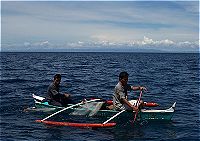
|
MARINE FISHES and MARINE INVERTEBRATESChain of Custody and Handling ProceduresThe Philippines is an archipelago in South East Asia, located near the equator. Bays and Coastal Waters cover an area of 266,000 sq.km. Its oceanic waters cover 1,934,000 sq.km. The total length of the coastline is 36,289 km. It lies in the Coral Triangle (along with parts of Indonesia and New Guinea) which missed an ice age about 18,000 years ago. This fact explains why the Philippines has one of the most diverse flora and fauna in the world. It is also famous for having the most beautiful marine fishes in the world. The journey begins in one of the many fishing communities located along the coastlines all over the country. Many of these are 3rd class municipalities with a maximum annual income of P10,000,000 or less, and a population of 65,000 or less. Each community consists of several families. One of the major industries in these coastal communities is fishing. Most of the fishermen catch food fishes, but we deal with a specialized group that collects live ornamental fishes for the aquarists. Further these fishermen specialize in either shallow water diving or join bigger groups who specialize in deep water diving. Our deep partnership with these fishermen mean that they know what kind of specimens to catch for us. They go out to sea to catch fishes. Shallow water divers return daily, while deep water divers spend a few days in the seas.  Our fishes are net caught by our net-trained fishermen. We supply them with free nets and regularly replace old nets. We also support our fishermen by lending them capital when needed to purchase additional equipment and to upgrade their fishing boats. Fishing boats are shared among several families to maximize the usage. Our fishermen are highly skilled and are able to catch fishes using nets only. Shallow divers just hold their breath and dive underwater to catch fishes. Deep divers have breathing equipment to reach deeper areas and stay underwater for extended periods. Once they return to land, the other family members assist by packing the fish in separate bags, and put them in huts. Water changes are done 2 to 3 times a day. Other communities have make shift holding areas. These communities are trained in handling fishes so that these are properly cared for as soon as they are caught. The fishermen accumulate enough fishes to fill up a small van. It is usually the head fisherman or his wife who will accompany the fishes to our warehouse. The travel time is at least 5 hours by land.
Our fishermen communities regularly bring in their catch to our warehouse, usually once a week. Fishes are acclimatized in our screening area, before they are screened by our staff. Sometimes, there are excess fishes that are not desirable, and we ask the fishermen to return them to the sea. The fishes that pass the screening process are placed in the quarantine tanks for observation. After a few days, we move them to the holding area, to further observe them and start training them to get used to aquarium life and eating fresh, frozen and dry food. The conditioning process takes about a week. Our expert team of screeners and staff, who have many years of experience, make sure the fishes are well acclimatized and healthy before they are tagged as ready for shipment. These fishes are put in our stock list, but many are already pre-ordered by our regular customers. Once the orders are finalized, these fishes are transferred to the packing area, for 24-48 hour observation period. Finally, on the day of shipment, these are double-screened before packing and shipping them out. We do not take shortcuts in our process, to assure the best possible quality fishes for our customers.
Be sure to check out the virtual tour for more information about our aquarium warehouse and fish gallery for pictures of some of the fishes we can supply. |






